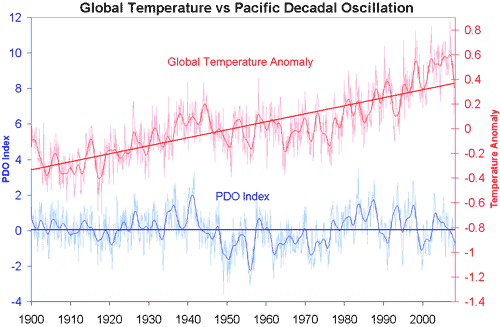Natural cycles can only move heat around, like from the oceans to the atmosphere. But now we see adding of heat both in oceans and the atmosphere. So the adding of heat to the energy budget we see now must come from somewhere else than natural cycles.
Natural oscillations like PDO simply move heat around from oceans to air and vice-versa. They don't have the ability to either create or retain heat, therefore they're not capable of causing a long-term warming trend, just short-term temperature variations. Basically they're an example of internal variability, not an external radiative forcing. If PDO were responsible for warming the surface, the oceans would be cooling, which is not the case.
These results are expected. The long term warming trend is a result of an energy imbalance caused primarily by an increase of greenhouse gases in the atmosphere. In contrast, the PDO is an internal process and does not increase or decrease the total energy in the climate system.
https://www.skepticalscience.com/Pacific-Decadal-Oscillation-advanced.htm

No credible study has suggested that ocean oscillations can account for the long-term trends. The key observation here is the increase in ocean heat content over the last half century (the figure below shows three estimates of the changes since 1955). This absolutely means that more energy has been coming into the system than leaving.
http://www.realclimate.org/index.php/archives/2017/04/judy-currys-attribution-non-argument/#comment-677575
Now this presents a real problem for claims that ocean variability is the main driver. To see why, note that ocean dynamics changes only move energy around – to warm somewhere, they have to cool somewhere else. So posit an initial dynamic change of ocean circulation that warms the surface (and cools below or in other regions). To bring more energy into the system, that surface warming would have to cause the top-of-the-atmosphere radiation balance to change positively, but that would add to warming, amplifying the initial perturbation and leading to a runaway instability. There are really good reasons to think this is unphysical.
Natural oscillations like PDO simply move heat around from oceans to air and vice-versa. They don't have the ability to either create or retain heat, therefore they're not capable of causing a long-term warming trend, just short-term temperature variations. Basically they're an example of internal variability, not an external radiative forcing. If PDO were responsible for warming the surface, the oceans would be cooling, which is not the case.
These results are expected. The long term warming trend is a result of an energy imbalance caused primarily by an increase of greenhouse gases in the atmosphere. In contrast, the PDO is an internal process and does not increase or decrease the total energy in the climate system.
https://www.skepticalscience.com/Pacific-Decadal-Oscillation-advanced.htm

No credible study has suggested that ocean oscillations can account for the long-term trends. The key observation here is the increase in ocean heat content over the last half century (the figure below shows three estimates of the changes since 1955). This absolutely means that more energy has been coming into the system than leaving.
http://www.realclimate.org/index.php/archives/2017/04/judy-currys-attribution-non-argument/#comment-677575
Now this presents a real problem for claims that ocean variability is the main driver. To see why, note that ocean dynamics changes only move energy around – to warm somewhere, they have to cool somewhere else. So posit an initial dynamic change of ocean circulation that warms the surface (and cools below or in other regions). To bring more energy into the system, that surface warming would have to cause the top-of-the-atmosphere radiation balance to change positively, but that would add to warming, amplifying the initial perturbation and leading to a runaway instability. There are really good reasons to think this is unphysical.
Remember too that ocean heat content increases were a predicted consequence of GHG-driven warming well before the ocean data was clear enough to demonstrate it.
Arctic sea-ice decline weakens the Atlantic Meridional Overturning Circulation


Ingen kommentarer:
Legg inn en kommentar